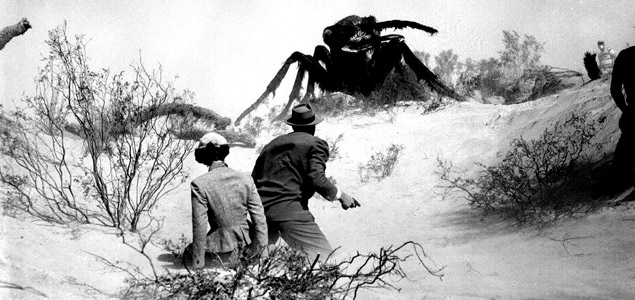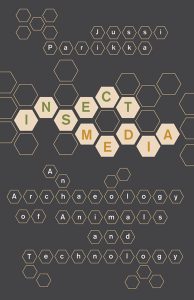
Them! (1954)
They are everywhere and they can be perceived as quite the alien intelligence; six-legged, with their numerous eyes, capacities of motion and sensation so different from our own. No wonder science fiction has been inspired by insects. But also other fields, like robotics as well as network design. Insects are more than creepy-crawly bugs; they are also a central reference point of so much of network culture, from talk of hive minds and distributed networks to algorithms that function like ant colonies; some refer to our cognitive capitalist practices as “pollen society”.
It is in this context that I talk of insect media — the entanglement of notions borrowed from biology with high tech technology; understanding media culture through such seemingly simple examples of life which however outperform humans in so many ways. The idea of insect media is then a theoretical as well as a cultural historical exercise to understand the long exchange between discourses of technology and discourses of biology.
Science fiction is a good example. If you want to be futuristic, you do not anymore fantasize in terms of humans and animals,or androids and humanoids; instead preferably insects and other non-human animals. This is the lesson one gets even from a glimpse of past years of science-fiction discourse, such as Ian McDonald’s The Dervish House. The nanotechnological future Istanbul is pitched as the 21st century version of the Silk Road node, defined by its booming nanotech cluster of businesses and tech companies. The Cronenbergian 1980s fantasies of human-insect–hybrid (as in the Fly) are superseded by the fiction version of spider robotics and insectoid-drones part of security and surveillance regimes in Istanbul plagued by various suicide sects.

First edition of Gläserne Bienen (1957).
It’s not that swarms themselves are new. Their history goes back to early twentieth century research into “superorganisms” and the collective mind that for instance ant nests seemed to exhibit. This is the pre-digital version we are being offered now of the internet society: a world of connectivity and emergent intelligence. Indeed, a whole longer history of cultural techniques of swarming is to be considered in relation to the actual technological development in smart robotics. Fiction of Ernst Jünger is again emblematic of a certain epistemological framing of media “development”, as already in his Gläserne Bienen, The Glass Bees (1957) he pitched a future of nanorobotics. In Jünger’s vision, this was tied to a becoming-obsolescent of the actual animal worlds, which corresponds to the analyses of such writers as Akira Mizuta Lippit concerning the dual bind of modern urban technological landscapes and animals: disappearance of rodents and other non-humans is paralleled by the animalisation of media, which seems to be clear from even a cursory representational analysis of early media, so fascinated by agility of animal bodies as well as animation worlds of rodents and animal farms.
To follow the ideas by Lippit, the intertwining of animals and technology was an inherent part of the modernization and emergence of technical media at the end of the nineteenth century. The disappearance of animals from urban cultures of technical media was paralleled with the appearance of animals in various discourses from media (e.g. cinema) to modern subjectivity (e.g. psychoanalysis). As Lippit notes, from metonymies of nature animals became embedded in the new industrial environment, where the idioms and histories of numerous technological innovations from the steam engine to quantum mechanics bear the traces of an incorporated animality. James Watt and later Henry Ford, Thomas Edison, Alexander Graham Bell, Walt Disney, and Erwin Schrödinger, among other key figures in the industrial and aesthetic shifts of the late nineteenth and early twentieth centuries, found uses for animal spirits in developing their respective machines, creating in the process a series of fantastic hybrids.
There is a whole media zoology. This term is used in a parallel sense to that of a “zootechnical” approach to elaborate the wider entanglement of communication practices in relation to animal research – and in addition, as we will see below, to a wider media ecological stance. Media zoology refers to this cultural historical situation in which we design and understand high tech media culture through animal worlds.
But of course there is more to this grounding of media zoology than looking at media through its content and what is on the screen. Indeed, the worlds of such fiction as The Dervish House remind us that media as technologies – as abstract, yet embodied, as concrete, but massively distributed in wireless and network age – work much more efficiently when they are not modelled on the human form. This is why marine biologists turned US military and security advisors, talking about octopuses make international news. I am referring to the University of Arizona marine ecologist Rafe Sagarin advising on learning about decentralised organisational methods from the tentacle marine creatures. The handbook for such experimental ideas is of course the media philosopher Vilem Flusser‘s Vampyroteuthis Infernalis: A Treatise, with a Report by the Institut Scientifique de Recherche Paranaturaliste.
In terms of media theory, this relates bypassing of some of the traditions of theory of technology from Ernst Kapp to Marshall McLuhan. A lot of them have tried to suggest that we always design media as models of the human and as extensions of Man. Instead, as for instance Siegfried Zielinski has argued too media are much weirder in their relations to the world.
Hence, in this spirit of media archaeology and even media variantology, there is another tradition of media theory that we can excavate. This alternative takes aboard animals in various forms and starts the theoretisation of media from a different set of affordances. Indeed, when talking of media ecology, one should not forget the early writings of Harold Innis, which feature such literally ecological themes as rivers, fur and beavers as well as the more conceptual takes on “medium” that track its history in between biology and technical media. Reading through early ethological and biological literature from 19th and early 20th century, one discovers a range of attempts to pitch a cross-discplinary approach to for instance insect lives, which resembles almost an attempt to understand the tiny animals through “cultural” techniques: the life of insects is one of dance, acoustics, communication and housing, as for instance in J.H.Fabre’s Social Life in the Insect World.Such dilemmas of methodological and theoretical interest are expressed by William Morton Wheeler, a pioneer in the study of social life of animals and a writer on “emergence” way before it was captured as part of complexity theory. In early 20th century, Wheeler lamented the restriction of the notion of the social and its scope: “Unfortunately, also, the science of comparative sociology has remained undeveloped. It has, in fact, fallen between two stools, because the sociologists have left the study of the animal and plant societies to the biologists and the latter have been much less interested in these societies as such than in the structure or individual activities of their members.” What if his willingness to expand social sciences to animal and plant lives could be taken as a further step to suggest the same with our media related investigations? If so many of the early research into animal psychology and formations of the social could be seen, anachronistically, as tongue in cheek mapping of cultural techniques of non-human life, perhaps we can more seriously suggest an extended mediatic approach to animals but also other elements of the non-human ecology – organic and non-organic?

Insect Media: An Archaeology of Animals and Technology. Jussi Parikka (2010).
Indeed, we need approaches such as “insect media” that rigourously track the cultural, historical and mediatic contexts in which technological media culture develops. This is even more urgent now, in the midst of the current ecocatastrophe: electronic waste is one of the growing problems, and all of our high tech electronic gadgets carry with them toxic material. Cloud computing demands huge amounts of energy. Media technologies are themselves embedded in ecological consequences, not just animal metaphors. Perhaps ecology and animals are better and more ethical ways to understand technical media culture?



leif BRUSH | 25 January 2013
1973 Insect Broadcasting
“Leif Brush, Duluth, Minnesota, where he transformed his spacious garden into an artists studio. The long brass ribbon is one of his terrain instruments: the Wind Ribbon. The long brass ribbon is supplied with contact microphones. To hear the sounds captured, we had to step inside the space on the ground floor of the Budascoop building, where a furnished a room dedicated to Brush’s work, including (an inside version of) another of his terrain instruments: the Insect Recording Studio. Here are a 13 minutes and 23 seconds of the sounds that I recorded from the ribbon’s ongoing live stream, around 20th on Tuesday, May 8th, as if by magic, the Sounding City’;s ribbon at a particularly tumultuous moment in time.”
Guy de Bièvre and Sofia von Bustorff
http://icecast01.v2.nl:8000/windribbon
http://www.resonancenetwork.eu/images/2012Kortrijk_LeifBrush.jpg
http://www.d.umn.edu/~lbrush/lbarchivese.html#anchor85180
Oriol Abad Hogeland | 04 February 2013
Les necessitats i el desenvolupament van agafats de la ma, no sempre caminen junts, pero quan ho fan i alguna cosa els crida l’ atencio s’aturen i observen en alguna direccio.
Leave a comment